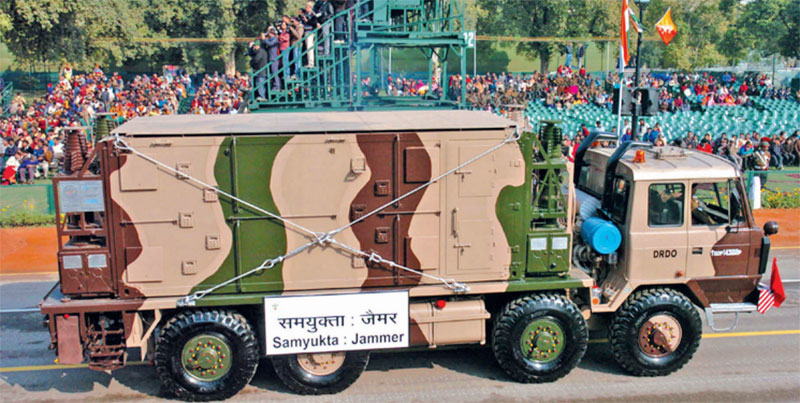Electronic Gaps
Mohammad Asif Khan
Electronic warfare (EW) is an essential part of warfighting. Cognisant of this, India has been making efforts to plug its gaps in advanced EW systems. Electronic warfare uses the electromagnetic spectrum to intercept, jam, or disrupt enemy communications, radar systems and other electronic systems while protecting one’s own. It is divided into three main components: electronic attack (EA), which disrupts enemy operations through jamming and deception; electronic protection (EP), which protects friendly systems from enemy EW activities; and electronic support (ES), which involves gathering intelligence through electronic means. While these components are fundamental to modern warfare, India’s application and integration of these systems reveal both strengths and significant weaknesses.

The SAMYUKTA Jammer passing through Rajpath on the Republic Day Parade
The Defence Research and Development Organisation (DRDO) has recently developed two EW systems: Samyukta and Divya Drishti. Samyukta is a versatile EW system designed to operate in various terrains. It provides electronic intelligence (ELINT) and electronic countermeasures (ECM) capable of intercepting and jamming enemy communications and radar signals. The development of the Samyukta electronic warfare system was a collaborative effort led by the Defence Electronics Research Laboratory, Bharat Electronics Limited, Electronics Corporation of India Limited, and the Corps of Signals of the Indian Army. Private companies like Data Patterns India Ltd (Chennai), CMC and Tata Power Company Limited (Strategic Electronics Division) played significant roles. Approximately 40 companies contributed by manufacturing various components domestically. In an interview conducted by KVS Hari for the IEEE History Center on 7 January 2022, Vasudev Kalkunte Aatre discussed the challenges faced due to US sanctions following India’s 1998 nuclear tests. He stated, "One of the main challenges was overcoming the sanctions imposed by the United States after India’s 1998 nuclear tests, which restricted the import of advanced electronic components.”
Divya Drishti is an advanced electronic support system for real-time interception and analysis of radar emissions. It enhances situational awareness and threat detection. During recent border skirmishes, Divya Drishti monitored enemy radar activities, providing real-time data to Indian commanders. However, its effectiveness has been limited by issues related to data integration and interpretation. There have been instances where the system failed to provide timely and actionable intelligence, leading to missed opportunities and strategic
Subscribe To Force
Fuel Fearless Journalism with Your Yearly Subscription
SUBSCRIBE NOW
We don’t tell you how to do your job…
But we put the environment in which you do your job in perspective, so that when you step out you do so with the complete picture.








